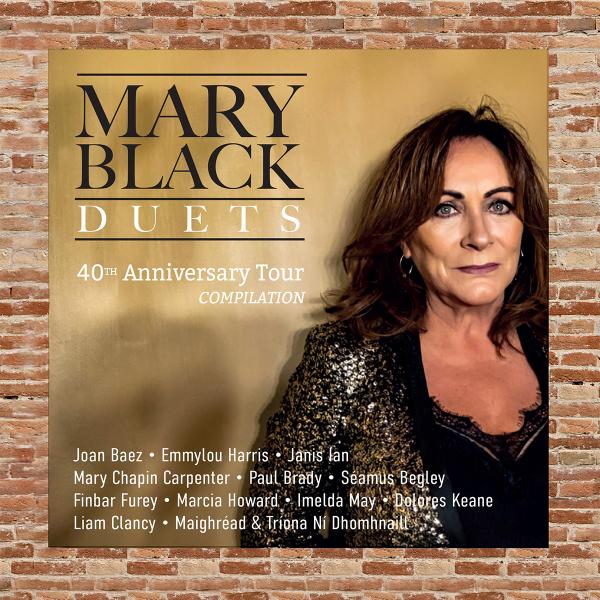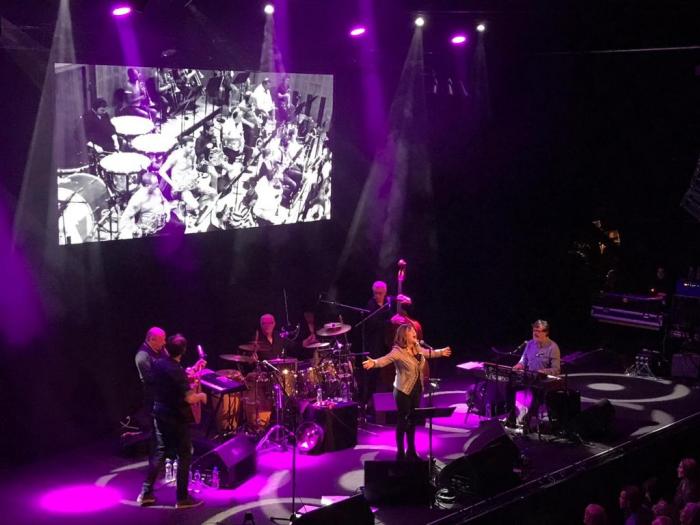Platinum Becomes Her
Although mysteriously absent from mainstream American radio airwaves, Mary Black has been a staple of Ireland's music scene for over 20 years. Indeed, as a testament to her longevity as an artist, Black won Irish Music Magazine's Irish Music Award 2003 for Best Contemporary Female artist.
Mary Black sprang into the Dublin folk scene of the mid-1970's, along with her three brothers and sister Frances, as a member of The Black Family. From the beginning, Black's voice had a quality that sounds both plain and elegant, with a rich and satisfying timbre that easily stands by itself a capella. However, when she left The Black Family, she began to transition away from traditional Irish singing and toward popular music with a nonetheless distinctly Celtic flavor.
With each album release, her reputation and population have grown. Her 1983 debut album Mary Black, produced by Declan Sinnot, earned her a gold album in Ireland. In 1983, Anthem, her LP with the legendary Celtic group DeDannan. won the Irish Album of the Year award. Her subsequent 1985 release, Without the Fanfare took a distinctly more contemporary musical turn. This further established her expanding solo career, and led to her departure from DeDannan in 1986. Later that year, she received Ireland's Entertainer of the Year award.
Her biggest commercial success to date came in 1989's No Frontiers, which went triple platinum. It is an artistic tour de force, with arresting instrumentation and crisp production emphasizing the well-chosen and beautifully delivered lyrics. The exceptional Waiting for Columbus, written by master lyricist Noel Brazil, showcases Black's stunningly controlled and impassioned voice. Like Joan Baez, she has a long, cello-like vibrato ending her lines like a last long draw across the strings of a violin. Also highly successful, Black's next album, Babes in the Woods came two years later, with several beautiful songs by Australian poet Howard Shane, and the title track by Noel Brazil. It was Ireland's number one album for six weeks that summer.
With Black's 1993 release, The Holy Ground, Billboard featured her on the cover, hailing her as "a firm favorite to join the heavy-hitting ranks of such artists as Enya, Sinead O'Connor and Clannad's Maire Brennan in the international marketplace."
Unfortunately, none of the songs received much airplay, as they never got onto the ever-elusive Abrams top-play rotation (a fate so many fine folk artists have long endured). Mary Black did, however, receive awards for Best Irish Female Vocalist and Best Irish Album that year at the Irish Recorded Music Awards.
In 1994, she was featured in the groundbreaking women's compilation A Woman s Heart, which also included performances by Maire Brennan, Eleanor McEvoy, Dolores Keane, Sharon Shannon, and her sister, Frances Black. The album was a huge success, and sales were strong - enough for each household in Ireland to own at least one copy.
Mary Black has worked very hard to not be described as a Celtic or Irish singer. On her website www.mary-black.net, she is quoted as saying, "I started in folk music, but never felt there should be any boundaries in music. Fortunately, here in Ireland there's an openness about music that allows you to step outside the categories." Indeed, some of her songs almost seem like a musical missing link, a perfect blend between Celtic and American folk, with more than a nod to American country and swing. Perhaps the nearest term you could use is Pan Celtic.
Her songs do, however, often deal with traditionally Celtic themes like mysticism and the magic found in nature. For example, in Bright Blue Rose, the Jimmy McCarthy song on Babes in the Woods, she sings:
And it is a holy thing, and it is a precious time
And it is the only way.
Forget-me-nots in the snow,
It's always been and so it goes
To ponder his death and his life eternally.
This lovely delicate dirge, part jazz and part Celt in flavor, is not haunting in the Celtic sense. However it stays with you, and you find yourself thinking about it long afterwards. It's not surprising that Babes in the Woods was voted one of the top 10 albums of the year by Britain's Today Newspaper. What is surprising is that such an excellent work received so little airplay in the United States.
Throughout her career, Mary Black has drawn from a pool of amazing lyricists, including Noel Brazil, Thorn Moore, Jimmy McCarthy, and Howard Shane. Her choice of covers encompasses an eclectic range of female songwrit-ers, and includes Joni Mitchell's Urge for Going, and Mary Chapin Carpenter's Moon and St. Christopher. She has joined Joan Baez for Ring Them Bells, which they performed together live at New York's Bottom Line Club.
The topics addressed on Black's songs tend toward the intellectual. Some are political, others heartfelt. She broaches difficult subjects with a straightforward delivery. Much to her credit, the choice of songs expresses a politically active sensibility, and in the folk tradition, strives to educate by the lyrics she sings. What sets her apart is that she does so without seeming preachy or heavy. On songs like The Shadow, which laments the horror and waste of religious entanglements in Northern Ireland, Mary avoids any overt dramatics. Instead, her delivery is straightforward and expository. It is annunciated calmly and directly to the listener, so that you are free to derive any meaning and conclusion on your own. A key element of Mary Black's success is her ability to find the heart of the song, that elusive quality of making you feel it just by closing your eyes and listening.
Mary Black has 18 solo albums - 9 platinum - and has performed with the groups DeDannan, The Black Family, Arcady and General Humbert. Her albums typically borrow from diverse sources and rhythms, with some surprising use of salsa, Breton folk cadences, and even American country. Her influences range from Fairport Convention to Billie Holiday and the Beatles. The instrumentation she employs is refreshing and unique, with simple bodhran and a light folk guitar, often synthesized with whimsical clarinet and sparingly used Celtic fiddles in the background.
Mary Black's current tour brings her to Los Angeles for two shows in March. So, open your daytimer, and circle March 25th for Carpenter Center in Long Beach and March 26th for UCLA's Royce Hall. Whether or not you're familiar with Mary Black's work, seeing her perform live is sure to be a satisfying experience.
If you can't go to her shows, go to www.mary-black.net and check out last year's Mary Black Live for an excellent overview of her career. Along with the CD, you receive video clips on VHS or DVD. Also available at the website is a limited edition of Women's Heart Trilogy. A nice feature of this website is that at checkout, there is a space provided for the purchaser to choose whether or not they would like Ms. Black to autograph their purchase.
J.J. Ryan has been a features writer for 30 years and has been published in Little Bit Magazine, The Reader, City Pages, Mpls./St Paul magazine and Sweet Potato Magazine in Minneapolis. She has also performed as lyricist and lead singer for her own band.


